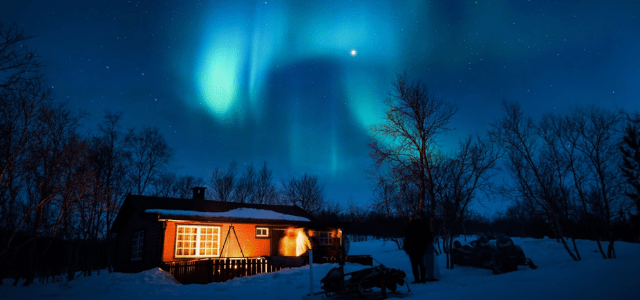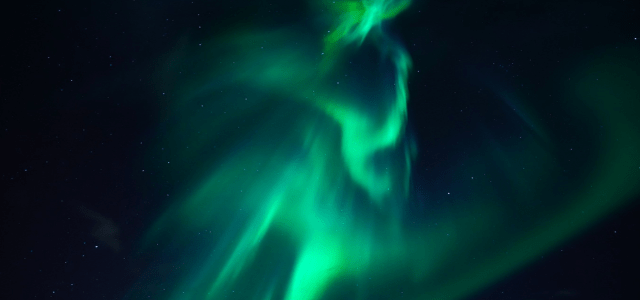There are very few natural phenomena which have the dynamism to keep you spellbound for the rest of your life. Once observed, Aurora Borealis imprints your memory with its multifarious colours which are hard to erase.
What is Aurora Borealis?
Aurora Borealis or the Northern Light is the greatest light show on earth caused when electrically charged particles emitted from the Sun enter the Earth’s atmosphere and collide with gases such as Nitrogen and Oxygen. When different particles collide with different gases high above the Earth, there’s a spectacular show of an array of colours in the sky.
Particles colliding with oxygen atoms create a yellow or green colour through interaction with higher altitude oxygen can cause an all red show in the sky too. Similarly, particles interacting with atoms from Nitrogen are responsible for the more vivid blue and purple lights. Only the Northern and the Southern hemisphere is blessed with these lights dancing around in the sky.

What to Expect?
If you ever happen to watch the Northern Lights, it will instantly transfer you into the land of fairy tales. One moment your eyes are relinquishing the lucid green blanket covering the sky which then abruptly gives way to an eloquent purple. This theatrical show of colours, as if having a mind of its own, then suddenly decides to disappear only to reappear at a different horizon in a more dramatic shape. It might appear in all its glory one night and might not show up at all the next. One attribute that she expects from the travellers is patience.
It definitely varies in colour and intensity at any given time. Different people with perspectives of their own decipher the shapes in their own way. Some say it looks like flickering curtains or a dancing Sea-horse or a crescent moon twisting and curling across the sky. The longitudinal extent of this arc of light can be as long as several thousand kilometres, but the width is usually narrow.
View of the Aurora from Iceland

So, now that you’ve travelled as far as Iceland and caught a glimpse of Aurora Borealis is marked in bold and in capitals in your bucket list, there are a few pointers you need to remember to make sure you have the best experience of viewing these lights.
The first and the foremost rule is to avoid light from any source around you. That means you have to get away from whichever city you are in. The darker the area around you the better the chances of you viewing them in all the prominent colours. If you’re in Reykjavik, Grotto lighthouse is your best bet for catching a glimpse.
The second important factor is the cloud cover. So there could be a spectacular dance show going on in the sky but if there is a thick blanket of cloud over you, forget about it. So always make sure that before you plan your trip, you keep a keen eye on the weather forecast over the region you’re planning to stay.
Planning the time of the year when you’re going to visit is of equal importance if not more to improve your chances for a sighting. The best months for viewing the northern lights is from August to April with the most intense colours visible in October and April.
These are some useful links which will help in planning your quest for the northern lights.
- Iceland Weather + Aurora
- Shows cloud cover
- Geophysical Institute
- Rating of how likely/intense they will be
- Soft Serve News
- It breaks down kV activity in half-hour increments.
The Mythical Lights
In the pre-scientific era, the northern lights were a profoundly unsettling experience. Imagine the mystery created by a massive blanket of bright lights up in the sky dancing away to glory or fiercely depending upon how you look at it, made the people in the region uncomfortable. They came up with myriad stories about the Northern lights. Among the inhabitants, the stories that came up were from their own religious beliefs. Some claim that the lights shine from the armour of war-like virgins riding horses in the sky, while the others say it is a fire bridge across the sky built by the Gods. Native Americans call in the Dance of the Spirits. Some consider it as omens from God.
Some Fun-Facts about the Northern Lights
- The closest the northern lights ever came to earth is 80 km above the surface.
- Contrary to common notion, the northern lights can be seen even on a full moon night.
- It doesn’t have to be cold to view the northern lights; it just needs to be dark.
- The Northern lights are here to stay; they are not going to disappear as claimed by many a click-bait website.
So, when in Iceland bundle up, stay late get out of town and be patient to tick-off the most significant check on one’s bucket list.
Happy Sighting!
Saumya works at The Villa Escape – Iceland Packages From India as editor. She is a 20-something fun-loving and ambitious female who loves travelling and loves to share her traveling experiences. She loves solo travel trips. If not travelling you can find her behind her laptop playing games.
